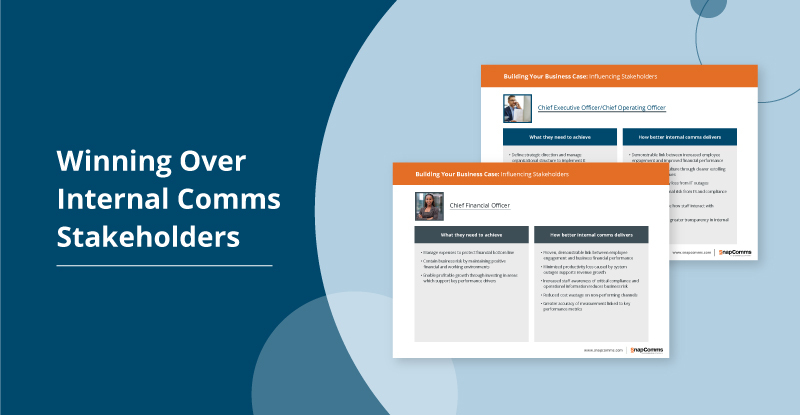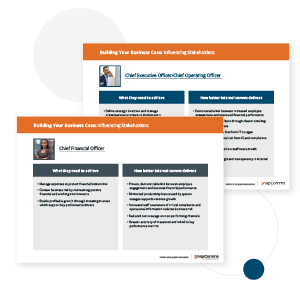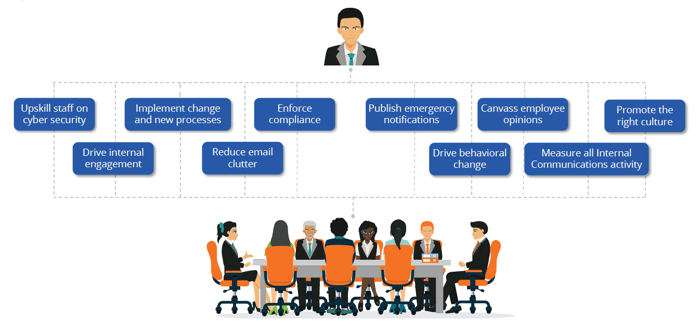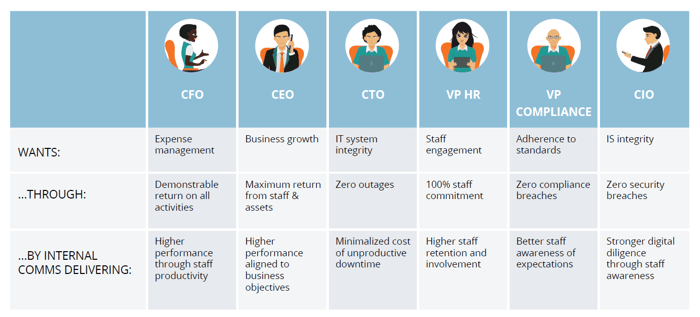
Upgrading your internal communications platform can sometimes hit an unexpected roadblock. Objections from other business stakeholders.
During discussions with stakeholders, or presenting your business case to the approval committee, you’re likely to encounter objections to what you’re proposing.
Sometimes these will be misconceptions about just what employee engagement solutions are, or the value they provide. Other times they will be resistance to cost or introducing new software.
Once you’ve identified your communications need an upgrade, and you’ve written your internal communications business case, the last step is engaging stakeholders. Part of this is countering objections. It’s a skill you’ll need to master if your internal comms goals are to be achieved.
In the third and final part of this series, we’ll show you how to overcome objections and successfully manage stakeholders. Plus we'll give you a useful stakeholder engagement guide to download.
Countering 11 Common Objections
Here are some common objections around introducing a new internal communication platform, plus how to respond to each.
| THEIR OBJECTION | YOUR RESPONSE |
| 1. We don’t need new employee engagement tools |
Most organizations would agree that their staff are their greatest asset. An investment in better employee engagement is an investment in growth. Remember, productivity increases 21% in organizations with engaged employees. If you have more specific communication objectives, perhaps to address known problems, you may only require one or two dedicated tools rather than a full solution platform. |
| 2. We’re happy with email |
Really? Email can still have a place, but the efficacy of this 30-year-old technology has been in decline for some time. Readership and engagement rates continue to drop – meaning staff aren’t reading, absorbing or interacting with what you’re saying. Do you really want to leave that to chance? |
| 3. We already have Slack |
That's a great tool for staff to collaborate and send messages to each other on, but it's not designed for fast delivery of information that employees need to read. On Slack, everyone has an equal voice, which means messages of high importance, or those which demand a response, are easily missed. Collaboration tools also tend to be ignored more by employees, because they’re busy with their workloads. That’s why internal comms tools can effectively complement and improve performance of your existing tools. |
| 4. This isn’t a priority for us |
Delaying will mean losing the efficiency gains, productivity gains and cost savings that you’ll otherwise enjoy – it also means improvements may take longer to achieve, as inefficiencies fester and morale declines in the meantime. Improved employee engagement tools don’t have to be your biggest priority, but they will help support and drive the success of your key projects. |
| 5. We have too many other initiatives underway |
That’s great – better staff engagement tools will raise awareness, generate anticipation and promote launch of your other initiatives so that they get best bang for employee buck! Don’t sell your exciting new initiatives short with uninspiring internal comms. |
| 6. There’s no way for us to judge the value of it |
Every good internal comms tool will have full tracking and reporting capabilities, so you’ll know exactly how each performs for readership and engagement. Collate your internal email performance rates as a benchmark to compare against – we know you’ll be pleasantly surprised with the results. |
| 7. We’re currently going through a period of change |
All the more reason to keep staff properly updated to reduce uncertainty and maintain productivity during these turbulent times. In the absence of good internal comms, rumors will spread and staff turnover will increase. It’s important for managers to fill any comms vacuum with messages which inform and reassure – cold corporate emails won’t cut the mustard! |
| 8. It’s too expensive |
Do you know how much your current comms tools are costing you? Email systems may appear cheap on the surface, but if they’re ineffective (and it’s proven that they generally are) they’re actually an expensive waste of money. Modern employee engagement tools are much more cost-effective over the medium term. If tiered pricing options are offered, these can also reduce your initial investment and demonstrate performance without over-committing up-front. |
| 9. We have no staff to manage it and create content |
Modern low-touch back-end interfaces means even staff with little technical skill can easily master it. This way, it takes hardly any time at all to learn and update – meaning it doesn’t impact significantly on any existing employee’s workload, nor do you need to hire anyone new. In fact, you’ll almost certainly find that staff using dedicated internal comms platforms save time, since it’s so easy to use compared to often time-consuming email and other tools. |
| 10. It will place extra burden on IT staff | Simple user interfaces mean staff from any department can be assigned as administrators. There should be no requirement for regular IT involvement – other than communicating any outages, if this is one of your organization’s needs. |
| 11. We don’t want to deal with lots of different suppliers |
That’s where the value of a single supplier lies – when all your internal comms solutions are with one supplier, you’ve no need to invest time and expense dealing with multiple suppliers. This saves effort up-front, but also ongoing when software updates or new releases are deployed. |
Engaging Stakeholders’ Hot Buttons
The larger your organization, the more different stakeholders are likely to be involved in any evaluation and decision – and the more protracted the approval process could be.
In small to medium-size workplaces, the process could simply be a formal ‘pitch’ and recommendation to your manager plus one or two of their peers.
However, in larger organizations of dispersed workplaces, sizable staff numbers and a global customer base, there will likely be a highly-structured, multiple-stage process of presenting your case to an approval committee.
Regardless of size, there will always be stakeholders who have their own unique goals. These goals will be distinct from other departments, and naturally enough will revolve around their own specific areas of responsibility.
For example, a Director/VP of Information Technology, a Chief Financial Officer and a Director/VP of Human Resources would be expected stakeholders in any organization. Each of these will have strong interest in any new employee engagement tool.
In larger organizations, additional stakeholders such as a Director of Information Security, Chief Compliance Officer and Chief Executive Officer are also likely to be included.
While each of these roles ultimately centers around the organization’s core goals and values, different objectives will exist at a department level.
Focus on the ultimate goal of achieving a positive outcome in terms of employee engagement – but be mindful that a wider array of specific objectives exists beneath this and feeds into it.
Tailor Your Pitch By Stakeholder
Certain stakeholders may be more difficult to convince than others. This might be because their specific objectives may conflict with yours (for example, a Finance focus on cost reduction versus an Internal Communications drive to improve employee engagement).
Or it could be because they’re less (or not at all) familiar with the current issues and solutions you’re presenting.
This makes it even more important to influence and persuade as many individual stakeholders as possible. Gaining the support of any means you can count on them supporting your proposal. What you’re seeking to do is build up a network of advocacy.
That's where you need a stakeholder engagement communication plan. Address the responsibilities and concerns of each stakeholder, as they relate to the solution of improved employee engagement. Then tailor what you say to each. 
We've created a guide highlighting each of the key stakeholders you may encounter when making your case.
This summarizes key responsibilities for each and how an upgraded communications platform supports these responsibilities.
Using this guide will better equip you to ‘speak the language’ of stakeholders and positively influence their response to your proposal. Complete the form to get a copy now.



